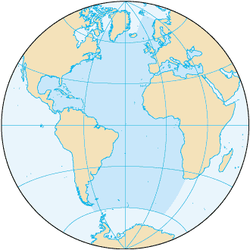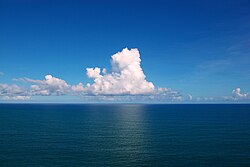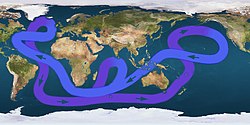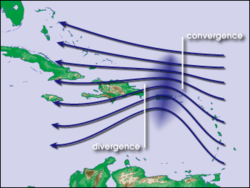Atlantic Ocean
The Atlantic Ocean is the world's second largest ocean. It covers a total area of about 106,400,000 square kilometres (41,100,000 square miles), about 20 percent of the Earth's surface.[1]
| Earth's oceans (World Ocean) |
|---|
It is named after the Ancient Greek god Atlas, the Titan in Greek mythology.
Geologic history
The Atlantic formed when the Americas moved west from Eurasia and Africa. This began sometime in the Cretaceous peiod, roughly 135 million years ago. It was part of the break-up of the supercontinent Pangaea.[2]
The East Coast of South America is shaped somewhat like the West Coast of Africa, which gave a clue that continents have moved over long periods of time in what is called continental drift. The Atlantic Ocean is still growing because of seafloor spreading from the Mid-Atlantic Ridge,[3] and the Pacific Ocean is shrinking because the sea floor is subducting, or folding under itself, into the mantle.
Geography
The Atlantic Ocean is bounded on the west by North and South America. It connects to the Arctic Ocean through the Denmark Strait, Greenland Sea, Norwegian Sea, and Barents Sea.[2] It connects with the Mediterranean Sea through the Strait of Gibraltar.[4]
In the southeast, the Atlantic merges into the Indian Ocean. The 20th meridian east defines its border.[4]
In the southwest, the Drake Passage connects it to the Pacific Ocean. The Panama Canal links the Atlantic and Pacific.[2]
The Atlantic Ocean is the largest ocean after the Pacific and had an area of 106,400,000 square kilometres (41,100,000 sq mi). The volume of the Atlantic, along with its bordering seas, is 354,700,000 cubic kilometres.[4]
The average depth of the Atlantic, along with its bordering seas, is 3,339 metres (1,826 fathoms; 10,955 ft). The greatest depth is Milwaukee Deep near Puerto Rico, where it is 8,380 metres (4,580 fathoms; 27,490 ft) deep.[4]
The RMS Titanic currently rests at the bottom of the Atlantic Ocean.
Gulf Stream
The Atlantic Ocean has important ocean currents. One of them, called the Gulf Stream, flows across the North Atlantic.[5] Water gets heated by the sun in the Caribbean Sea and then moves northwest toward the North Pole, which makes France, the British Isles, Iceland, and Norway, all in Europe, much warmer in winter than Newfoundland and Nova Scotia, noth in Canada.[5] Without the Gulf Stream, the climates of northeast Canada and northwestern Europe might be the same because both places are about the same distance from the North Pole.[5]
There are also currents in the South Atlantic, but the shape of the sea makes it have a smaller effect on South Africa.
Geology
The main feature of the Atlantic Ocean's seabed is a large underwater mountain chain, the Mid-Atlantic Ridge, which runs from north to south under the ocean at the boundary of four tectonic plates: Eurasian, North American, South American, and African.[6] The ridge extends from Iceland in the north to about 58° south.[6]
The salinity of the surface waters of the open ocean ranges from 33 to 37 parts per thousand and varies by latitude and season.[7]
Atlantic Ocean Media
This video was taken by the crew of Expedition 29 on board the ISS. The pass starts from just northeast of the island of Newfoundland over the North Atlantic Ocean to central Africa, over South Sudan.
The Aethiopian Ocean depicted in a 1710 French map of Africa
The Atlantic as seen from the shores of Clare Island, Ireland in 1981.
False color map of ocean depth in the Atlantic basin
Waves in the trade winds in the Atlantic Ocean – areas of converging winds that move along the same track as the prevailing wind – create instabilities in the atmosphere that may lead to the formation of hurricanes.
Excavation of the Ertebølle middens in 1880
References
- ↑ "How Big is the Atlantic Ocean?". National Ocean Service. National Oceanic and Atmospheric Administration, U.S. Department of Commerce. May 15, 2014. Archived from the original on December 2, 2016. Retrieved November 29, 2016.
- ↑ 2.0 2.1 2.2 Barnes, C.A.; Broadus, J.M.; Fleming, R.H. et al. (November 21, 2004). "Atlantic Ocean". Eneyclopaedia Britannica. Encyclopaedia Britannica Inc. Archived from the original on February 15, 2017. Retrieved November 29, 2016.
{{cite web}}: CS1 maint: uses authors parameter (link) - ↑ "Seafloor Spreading". National Geographic. National Geographic Society. 8 June 2015. Archived from the original on 21 November 2016. Retrieved 29 November 2016.
- ↑ 4.0 4.1 4.2 4.3 "The Atlantic Ocean" (PDF). Marine Biodiversity and Ecosystem Functioning EU Network of Excellence. p. 1. Archived from the original (PDF) on September 1, 2012.
- ↑ 5.0 5.1 5.2 "Gulf Stream". Encyclopedia.com. Dictionary of American History, The Gale Group, Inc. 2003. Archived from the original on 2016-11-17. Retrieved 2016-11-29.
- ↑ 6.0 6.1 "The Mid-Atlantic Ridge". United Nations Educational, Scientific and Cultural Organization (UNESCO). UNESCO World Heritage Center. Archived from the original on 2011-05-14. Retrieved 2016-11-29.
- ↑ Talley, L.D. (2002). "Salinity Patterns in the Ocean: Volume 1, The Earth System: Physical and Chemical Dimensions of Global Environmental Change". In MacCracken, M.C.; Perry, Dr. J.S. (eds.). Encyclopedia of Global Environmental Change (PDF). John Wiley and Sons. pp. 629–640. ISBN 0-471-97796-9. Archived from the original (PDF) on 2016-12-13. Retrieved 2016-11-29.
Other websites
- LA Times special Altered Oceans Archived 2009-05-10 at the Wayback Machine
- Oceanography Image of the Day, from the Woods Hole Oceanographic Institution
- National Oceanic and Atmospheric Administration Archived 2013-04-24 at the Wayback Machine
- NOAA In-situ Ocean Data Viewer Archived 2006-02-11 at the Wayback Machine Plot and download ocean observations
- CIA World Factbook information about Atlantic Ocean
- 0°N 30°W / 0°N 30°WCoordinates: 0°N 30°W / 0°N 30°W
- Oceans at the Open Directory Project
- www.cartage.org.lb Archived 2009-08-29 at the Wayback Machine
- www.mnsu.edu Archived 2010-06-03 at the Wayback Machine










